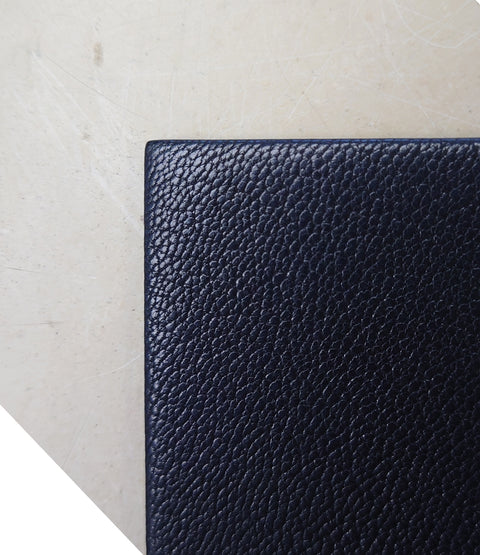This article was initially published in March 2016, and was revised in April 2018
A case binding that doesn't look like one
When I worked in England at Shepherds Bookbinders I came across a case binding construction which is essentially the same thing as a traditional binding (shoulders backed at a 90 degree angle, absence of French groove) but made just like a case binding with no lacing-in and covers made entirely off the book.
Today this structure (which I call English case binding) has become one of my favourite. I appreciate its streamlined, solid, compact feel, and of course I appreciate the fact that it is a case binding, for all the benefits that go with this.
I do it in a personal way that has evolved over the course of time thanks to notably, the research that I present to you here.
A frequent drawback
Having spent 3 years at the bench of Shepherds Bookbinders in London, I have made a great deal of English style case bindings. I noticed that, if they usually open very well in the middle, the opening of the board alone often pulls the flyleaf and first leaves of the book with it, which is not only annoying but also makes it feel like something is not quite right and could break sooner or later.
Case binding has always been, and continues to be considered an inferior style of binding, which in my opinion is the reason why there isn't much literature or debate about it. Back in London, whenever I asked colleagues, there were two typical approaches. Some considered it to be a normal feature of case bindings and that nothing could be done about them, and some did consider it a defect, but their answer was that 'it doesn't matter, it's a case binding'. Not many knew and practiced Arthur Johnson's theory, which is to make the shoulders higher than the boards.

Arthur Johnson, Thames and Hudson Manual of Bookbinding, 1978
Research
Shoulders higher than the boards, hah? Sounds weird, but it is true that I did notice different styles of backing practiced among the team members at Shepherds, and always thought there might be a link between the backing styles and the lifting -or not- of the flyleaf and first leaf of the book upon opening the cover. I thought that one day I'd have to make a research on this subject.
This moment came in march 2016 when I devoted a week to this experiment.
As a starting point I identified three styles of backing, based on my observations at Shepherds - flush with the board, higher than the board, and backed to below 90 degrees - which I applied to 3 identical book blocks.
First conclusions
1. In all styles there is a certain degree of pulling on the first leaves on opening, but it happens far less with the backing style nr. 2 (shoulder higher than board), which confirms Johnson's theory.
2. Backing at an angle less than 90 degrees doesn't present any advantage - I decide to leave this out of the research altogether.
3. Even though some degree of irregularity between the shoulder and the board is visible on all 3 styles, the first and last variations produce better results. With the second style where the shoulder is higher than the boards, a very pronounced 'mountain' can be seen and felt on either side of the spine. As we saw, this is the solution advocated by Arthur Johnson, but I don't personally like it, and I don't think my clients will, even if I explain the reasons to them. To me this solves a problem by creating a new one.
Taking a closer look
Next, I thought that even though I do not like the Johnson's solution, if I could understand why a higher shoulder makes for a stress-free opening of the board, I could perhaps use the principle to create an aesthetically more pleasing solution
So the next thing I did was to trim all my samples horizontally, 20 mm from the top edge, in the hopes to find clues on the edges .
One unexpected detail caught my attention: notice in the image below the slight difference in the endpapers shape (you might need to zoom in):
I noticed that the binding with no endpaper pull has a little hook at the fold of its endpapers, which the other one doesn't.
Could it be that this minuscule detail be the key? I had to find out.
In the binding on the left the hooked shape happened unintentionally, probably as a result of rounding, backing and smoothing the shoulder a little. But what if I intentionally created this shape from the start? I went back to work to make two new models. On one volume I tipped the endpapers about 1 mm further than the signature folds, so that they would hook around the signature folds slightly. The book block was backed flush with the boards, fraynot was applied over the whole thing but headbands and hollow were applied short of the shoulders so they wouldn't raise the shoulder level and also wouldn't be in the way of the hooked parts of the endpapers.
On the second volume I tipped the endpaper fold around a folio of white paper, and tipped this end in the conventional way.
Results
In both scenarios the books have a smooth appearance and feel, with shoulders level with the boards. The boards open well, and do not pull the fly leaves with them.
Below I tried to explain with a drawing why I think the endpaper construction fixes the problem : unlike fig.1 where the rotational movement is forced to happen on a very narrow line (the endpaper fold), fig. 2 shows how the hooked part of the endpaper provides extra width for the rotation to take place with less stress on the first leaves of the book.

Conclusion
Unlike my initial guess, the key to a stress-free board opening in an English case binding doesn't lie in the backing style but in the endpaper construction.
Whether this construction will present any drawback, time will tell. I have been using it for 2 years now, without any problem.
Any comments? Please feel free to use the form below
All the best,
Benjamin
Note
I have not taken into account here a method of casing-in that consists in gluing the endpapers to the inside of the boards in open position. This might constitute a solution to the lifting of the flyleaves but I have deliberately left it out as this would be stepping out of the category of case binding, where casing-in is done by gluing out the endpapers, closing the book and pressing.
Acknowledgements
I would like to thank Shepherds Bookbinders, and especially Peter Haigh, great specialist of case bindings, who let me look over his shoulder for three years in a row...







Comments (0)
There are no comments for this article. Be the first one to leave a message!